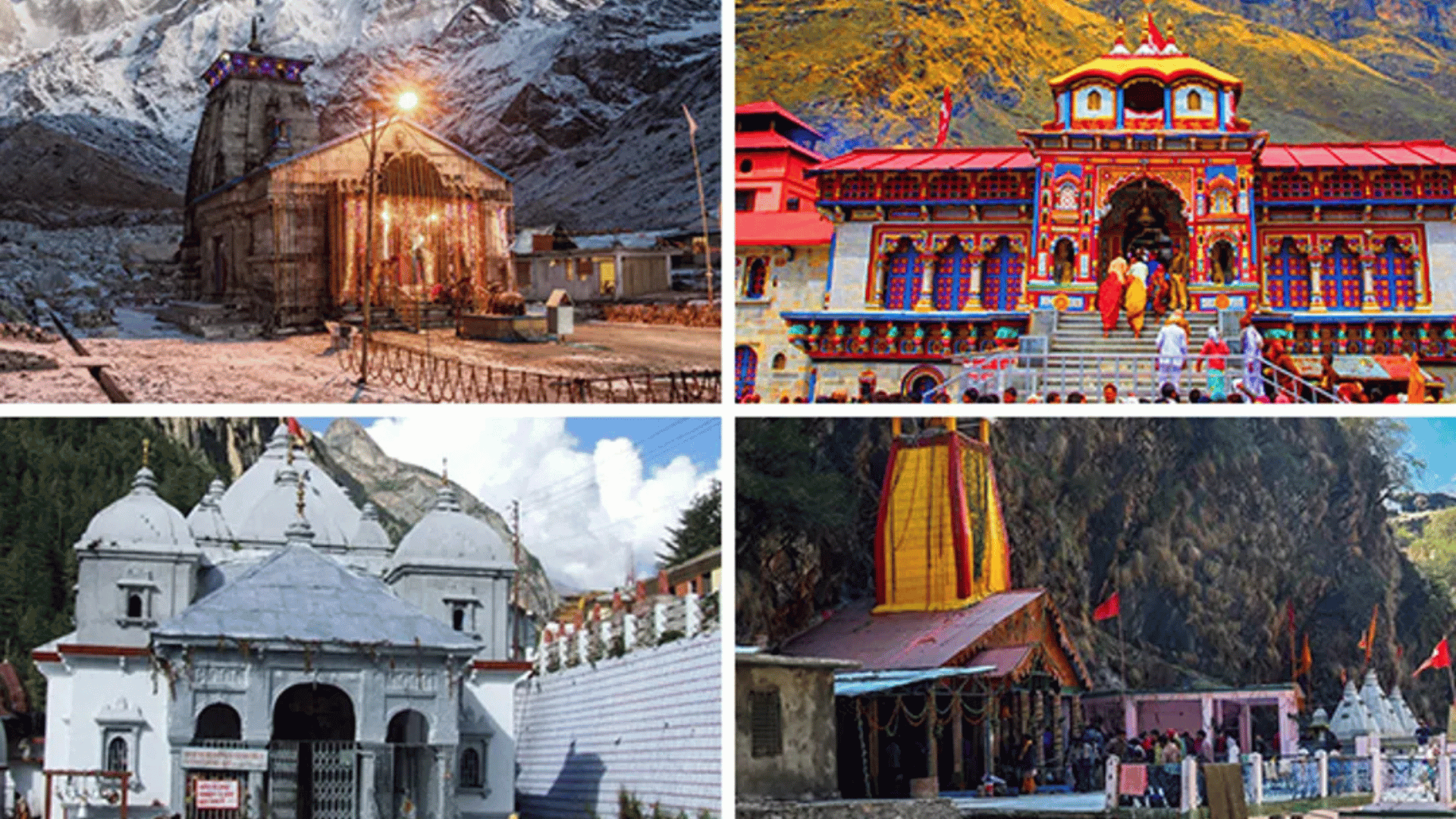Details regarding the Chota Char Dham pilgrimage in Uttarakhand
Uttarakhand, often called the Land of Gods (Devbhoomi), is a breathtaking region in the Himalayas known for its stunning landscapes and deep spiritual heritage. The Char Dham—consisting of Yamunotri, Gangotri, Kedarnath, and Badrinath—plays a central role in Hindu pilgrimage. Each Dham offers a unique blend of natural beauty, spiritual energy, and rich cultural history. This sacred circuit attracts worshippers year-round, as it is dotted with temples and holds immense significance in Hindu traditions.
The Char Dham Yatra is among the most important spiritual journeys in the region. The term ‘Char’ means four, and ‘Dham’ refers to holy sites. This pilgrimage circuit features four revered sanctuaries:
1. Yamunotri: the sanctuary of Goddess Yamuna.
2.Gangotri: dedicated to Goddess Ganga.
3. Kedarnath: the holy site of Lord Shiva.
4. Badrinath: the sacred abode of Lord Vishnu.
These sites are situated high in the Garhwal Himalayas, where the sacred rivers Ganga and Yamuna originate at Gangotri and Yamunotri, respectively. Kedarnath is part of the Panch Kedar, which includes the twelve Jyotirlingas of Shiva, while Badrinath is included in both the Bada Char Dham Yatra and the Panch Badri.
Embarking on the Char Dham Yatra is more than just a pilgrimage; it is a transformative journey focused on spiritual growth and
purification of the soul. Traditionally, devotees complete this sacred circuit in a clockwise manner, starting at Yamunotri, then proceeding to Gangotri, followed by Kedarnath, and culminating at Badrinath. In today’s fast-paced world, many pilgrims opt for the Do Dham Yatra, allowing them to visit two of the four Dhams, commonly selecting either Kedarnath and Badrinath or Yamnotri and Gangotri. Chota Char Dham pilgrimage season.
Embarking on the Char Dham Yatra is a unique blend of challenge and spiritual fulfillment. These sacred high-altitude shrines in Uttarakhand are accessible only from May to October, as they close for nearly half the year. The temples open on Akshaya Tritiya (falling in April or May) and close shortly after Diwali, specifically on Bhai Dooj (in October or November), marking the onset of winter.
The best time to experience the Char Dham, which includes Yamunotri, Gangotri, Kedarnath, and Badrinath, is from late April to early November. During these months, the weather is generally pleasant, making the journey both comfortable and enjoyable. Travelers have the option to reach these destinations by road or by air via helicopter.
Seasonal Breakdown
•April to June: This period offers ideal weather conditions, perfect for trekking and sightseeing. It’s the peak season, attracting numerous pilgrims and tourists due to its favorable climate.
•July to August: During the monsoon season, heavy rainfall can lead to landslides and travel disruptions, making it a less safe time to visit. Although the crowds thin out, the risks can outweigh the benefits.
•September to October: After the monsoon, the weather becomes clear and pleasant again, making this an excellent time to visit, especially in early October before the temples
close.
How to undertake the Char Dham Yatra in Uttarakhand.
1. Road
Embarking on a road trip to Chota Char Dham promises an extraordinary adventure, leading you to some of India’s most revered pilgrimage sites. Here’s your complete guide for a smooth and enjoyable journey:
• Starting Point
Delhi: Most travelers begin their expedition in Delhi, which offers excellent road connectivity to the Char Dham locations.
• Route Breakdown
Delhi to Rishikesh: The first leg of your journey spans approximately 240 km, typically taking 6 to 7 hours. Rishikesh serves as a crucial stop for those traveling to the Dham sites.
Rishikesh to Yamunotri: From Rishikesh, drive to Janki Chatti, about 220 km away. Once you reach Janki Chatti, a 6 km trek will lead you to Yamunotri.
Yamunotri to Gangotri: After exploring Yamunotri, return to Janki Chatti and continue your drive to Gangotri, which is roughly 210 km from there.
Gangotri to Kedarnath: Next, make your way to Gaurikund, located around 100 km from Gangotri. From Gaurikund, you’ll embark on a 16 km trek that leads you directly to Kedarnath.
From Kedarnath, take a drive of about 220 km to arrive at Badrinath.
• Road Conditions
Be prepared for narrow and winding roads throughout your journey. It’s crucial to drive cautiously and stay updated on any potential road closures, particularly during the monsoon season.
• Transportation Options
Private Vehicle: This option offers the most comfort and flexibility for your journey.
Shared Taxis: Conveniently available from major towns like Rishikesh and Haridwar, shared taxis are a popular choice for travellers.
Buses: State-run buses frequently operate from various cities, providing another reliable means of reaching these important pilgrimage sites.
• Travel Tips
Start Early: Leaving early in the day can help you avoid traffic and gives you ample time for exploration at each stop.
Pack Essentials: Don’t forget to bring necessary supplies, as facilities can be limited in some remote areas.
2. Train
Delhi and Haridwar are among the most popular travel destinations in India, boasting excellent rail connectivity. A variety of trains operate on this route, making it easy for travelers to reach their destination. Major railway stations such as Tuglakabad, Delhi Cantt, New Delhi, and H. Nizamuddin provide convenient departure points for journeys to Haridwar. For accurate and reliable train information, the official Indian Railways website is a great resource. It offers up-to-date schedules, travel durations, and other essential details.
Keep in mind that travel times can vary considerably depending on the train. Typically, the journey from New Delhi to Haridwar lasts between approximately 4 hours and 10 hours and 36 minutes, depending on the specific service chosen.
• The New Train route of 4 dham
The Char Dham Railway Initiative is a visionary project undertaken by the Indian Government and Indian Railways, designed to create a railway link to the sacred Char Dhams of Uttarakhand. This initiative will connect the holy sites of Yamunotri, Gangotri, Kedarnath, and Badrinath with major cities such as Haridwar, Rishikesh, and Dehradun.
The development of this railway line will occur in several phases, beginning with the routes from Rishikesh to Karnaprayag and from Dehradun to Uttarkashi. Once these primary connections are established, additional train services will be launched to facilitate travel to each of the four Dhams. While this project promises to significantly improve access for pilgrims and tourists, it must also navigate challenges related to the region’s rugged landscape, extreme weather, and high altitudes.
3. Private Chopper
The Char Dham Yatra by helicopter can be completed in approximately 4 to 5 days. The nearest airport to these revered sites is Jolly Grant International Airport in Dehradun. Helicopter services commence from the Sahastradhara Helipad in Dehradun. For travelers heading to Yamunotri, the nearest helipad is located in Kharsali. From there, a trek of 6 km will lead you to
the Yamunotri Temple.For Gangotri, the nearest helipad is Harsil, located about 25 km away from the temple. For Kedarnath, you can use the helipads at Sersi, Phata, or Guptkashi, which provide shuttle services to the sacred site. The helipad for Badrinath is conveniently situated just 1 km from the Badrinath Temple.
Trip to Temples offers various helicopter tour packages for both Char Dham and Do Dham journeys.
1. 4 nights 5 days 4 dham
2. 2 nights 3 days 2dham
3. Same day 2 dham
The Char Dham Yatra can be completed in 4 nights and 5 days, with accommodations for one night at each Dham and an additional complimentary night in Dehradun upon arrival. The Do Dham Yatra (Kedar-Badri) can be accomplished in 2 nights and 3 days, including a stay at both temples and a complimentary night in Dehradun. For those seeking a quicker option, a one-day tour without overnight stays is also available.
Chardham Yatra Itinerary
Chardham Yatra 5 nights and 6 days
Day 1 – Arrival at dehradun – Arrival at Dehradun airport/railway station – Transfer to hotel and check into the hotel and rest.
Day 2 – Yamunotri Dham – Arrival at Yamunotri – Check into the hotel and have breakfast – Transfer to Yamunotri dham temple for darshan – Also visit hot spring in Yamunotri temple, Yamuna Mata temple
and Shani Temple (Subject to time).
Day 3 – Gangotri Dham – Check out from hotel in Yamunotri – Arrival at Gangotri – Check into the hotel and have breakfast – Transfer to Gangotri dham temple for darshan – Also visit Bagodi Village or Ancient Laxmi Narayan Temple (Subject to time).
Day 4 – Kedarnath – Check out from hotel in Gangotri – Arrival at Kedarnath – Check into the hotel and have breakfast – Transfer to Kedarnath temple for darshan – Also visit Triyuginarayan Temple – It is the venue of celestial marriage of Lord Shiva and Goddess Parvati.
Day 5 – Badrinath – Check out from hotel in kedarnath – Arrival at Badrinath – Check into the hotel and have breakfast – Transfer to Badrinath temple for darshan – Also visit Mana Village – Known as the “First village of India” , due to it’s proximity to China border.
Day 6 – Return to Dehradun and Departure – Check out from hotel – Arrival at Dehradun – Passengers get transfer their Cloakrooms to collect their luggage and then have their breakfasts. – Transfer to airport/railway station.
Dodham Yatra for 3 nights and 4 days
Day 1 – Arrival at Dehradun – Arrival at Dehradun airport/railway station – Transfer to hotel and check into the hotel and rest.
Day 2 – Kedarnath – Check out from hotel in Dehradun – Arrival at Gangotri – Check into the hotel and have breakfast – Transfer to Gangotri dham temple for darshan – Also visit Bagodi Village or Ancient Laxmi Narayan Temple (Subject to time).
Day 3 – Badrinath – Check out from hotel in kedarnath – Arrival at Badrinath – Check into the hotel and have breakfast – Transfer to Badrinath temple for darshan – Also visit Mana Village – Known as the “First village of India” , due to it’s proximity to China border.
Day 4 – Return to Dehradun and Departure – Check out from hotel – Arrival at Dehradun – Passengers get transfer their Cloak rooms to collect their luggage and then have their breakfasts.
– Transfer to airport/railway station.
Dodham Yatra at Same Day
- Passengers will report at Sersi Heli
- Base
- Transfer to Kedarnath by shuttle helicopter from Sersi
- Transfer to Sersi and have breakfast
- Depart from Sersi for Badrinath.
- Arrival at Badrinath heliped and transfer for the darshan by car
- After darshan transfer back to Sersi heli-base.
• Departure.
1. Yamunotri Dham (Uttrakhand)
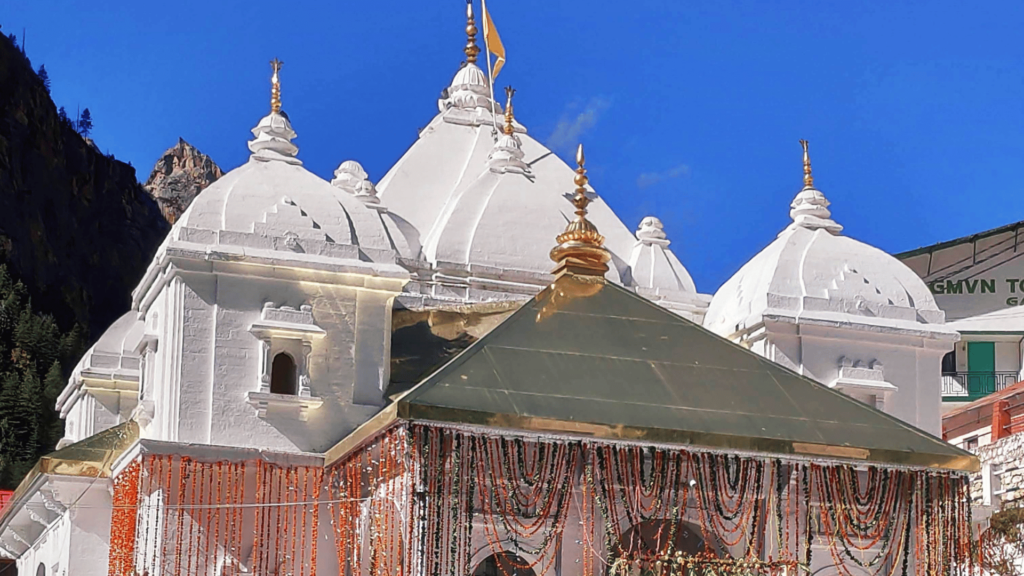
Yamunotri Dham: The Sacred Starting Point of the Chote Char Dham Yatra
Yamunotri Dham, the first shrine in the Chote Char Dham Yatra, is one of the most sacred and revered pilgrimage destinations in India. Located in the serene landscapes of Uttarkashi district, Uttarakhand, Yamunotri is the origin of the Yamuna River, which holds a prominent place in Hindu mythology as the second holiest river in India. Known as the daughter of the sun god Surya, Yamuna, or Yami, represents life and purification. Pilgrims believe that bathing in the river cleanses the soul, offering spiritual renewal.
The Sacred Temple and Rituals
At an elevation of 3,293 meters (10,804 feet) on the northern slopes of Bandar Poonch Parvat, the Yamunotri temple is accessible through a 6 km trek from Janki Chatti. This trek, surrounded by lush forests and stunning mountain views, is a vital part of the spiritual journey. Upon reaching the temple, pilgrims often dip into the natural hot springs nearby, continuing a unique ritual of cooking rice and potatoes in these hot springs, which are then offered as prashad to devotees as a symbol of purification.
The temple was built in the 1800s by King Narendra Shah and is dedicated to Goddess Yamuna. According to local legend, the philosopher Asit Muni is said to have meditated here, further enhancing the temple’s spiritual significance. During winter, the idol is moved to Kharsali village, which serves as the winter seat of the deity.
The Trek and Devotional Experience
The journey to Yamunotri is part of the Chote Char Dham pilgrimage, which begins with the trek from Hanuman Chatti. The 6 km path, adorned with vibrant greenery and breathtaking vistas of the Himalayas, offers pilgrims an immersive experience of nature’s tranquility. The trek is not only a physical journey but a spiritual one, providing a chance for reflection and rejuvenation.
At the temple, after the purification rituals in the hot springs, devotees pay homage to Goddess Yamuna, seeking her blessings for health, prosperity, and spiritual well-being. The backdrop of the majestic Yamunotri Glacier adds to the divinity of the site, creating a peaceful atmosphere that leaves a lasting impression.
Timings and Accessibility
The Yamunotri temple is open from 6:00 AM to 8:00 PM during the pilgrimage season. However, during the winter months, the temple is closed, and the idol is moved to Kharsali village for worship. As the westernmost shrine of the Chote Char Dham, Yamunotri marks the beginning of a deeply spiritual and transformative journey, setting the tone for the entire pilgrimage.
For pilgrims embarking on the Chote Char Dham Yatra, Yamunotri serves as a powerful starting point, offering both spiritual renewal and a chance to connect with the purity of nature.
2. Gangotri Dham (Uttrakhand)
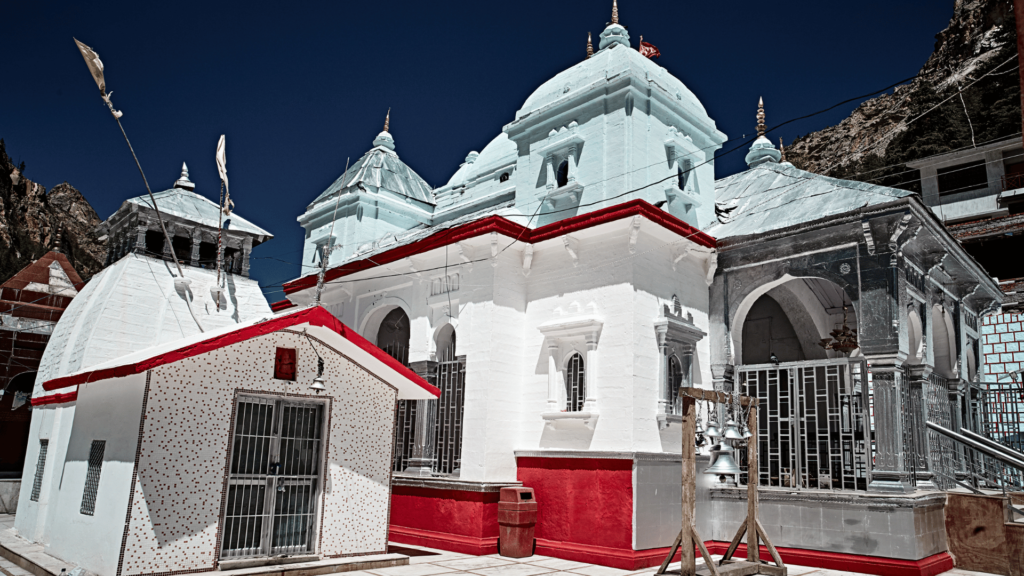
Located in the breathtaking Uttarkashi district of Uttarakhand, Gangotri Dham is the second sacred shrine in the revered Chota Char Dham Yatra. Surrounded by towering pine and deodar trees, this tranquil temple is dedicated to Goddess Ganga, the holiest river in Hindu tradition. According to legend, it was at this spot that the Ganges descended from the heavens when Lord Shiva released the river from his locks, responding to King Bhagiratha’s intense prayers.
A Sacred and Scenic Retreat
Perched at an elevation of around 3,100 meters (10,711 feet), Gangotri Dham lies near the Bhagirath Shila, the sacred rock where King Bhagiratha meditated. While the true source of the Ganges is located 19 kilometers away at Gaumukh, which is accessible only by a trek, the Gangotri temple itself is easily reachable by vehicle, making it accessible to pilgrims of all ages.
Constructed in the 18th century, the Gangotri temple attracts thousands of pilgrims annually, all seeking to honor Goddess Ganga and bathe in her purifying waters. During the winter months, the idol of Goddess Ganga is moved to the Mukhyamath temple in Mukhba village, which serves as her winter abode.
Spiritual Serenity and Natural Beauty
Gangotri Dham is not only a significant spiritual destination but also a place of remarkable natural beauty. The serene environment, combined with panoramic views of the majestic Bhagirathi peaks, creates an enchanting atmosphere that allows pilgrims to experience a deep sense of peace and devotion. The trek to Gaumukh offers an adventurous route for those wishing to explore the grandeur of the Himalayas, further adding to the sacredness and tranquility of the site.
For those undertaking the Chota Char Dham Yatra, Gangotri Dham serves as a vital stop on the journey, offering both spiritual solace and the breathtaking beauty of nature. It is here that spirituality and nature come together in perfect harmony, creating a truly unforgettable experience.
Timings and Accessibility
The Gangotri temple is open from 6:00 AM to 8:00 PM during the pilgrimage season. However, the temple is closed during the winter months, and the idol is moved to Mukhyamath in Mukhba village for the season. As the second shrine in the Chota Char Dham, Gangotri Dham continues to be a place of profound devotion, awe-inspiring landscapes, and an unforgettable pilgrimage experience.
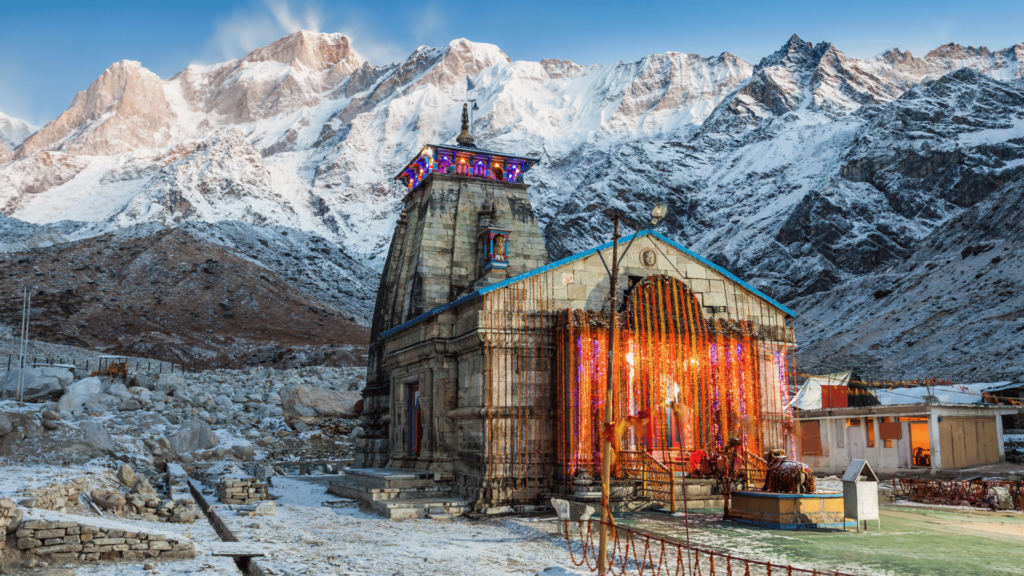
Kedarnath Dham is one of the most revered temples dedicated to Lord Shiva and is an essential part of the Chota Char Dham Yatra. Historically known as “Kedar Khand,” this sacred site holds great significance in Hindu mythology. According to legend, the Pandavas, in their quest for forgiveness after the Kurukshetra war, sought Lord Shiva’s blessing. To avoid their pursuit, Lord Shiva transformed into a bull and took refuge in Kedarnath, where he eventually vanished beneath the earth, leaving only his hump visible. His other forms are believed to appear at four other locations, known collectively as the Panch Kedar.
A Rich History and Renovation
The Kedarnath temple is believed to have been originally built by the Pandavas, later sanctified by the great philosopher Adi Shankaracharya in the 8th century AD. Following the devastating floods in 2013, the temple complex underwent significant renovations, adding modern amenities such as a helipad, hiking trails, and improved accommodations for pilgrims. These improvements have made it easier for devotees to access this sacred site while preserving its ancient charm and spiritual aura.
Scenic Beauty and Spiritual Serenity
Perched at an elevation of approximately 11,758 feet (3,584 meters) in the Rudraprayag district of Uttarakhand, Kedarnath Dham is surrounded by majestic snow-capped peaks near the Chorabari Glacier. The serene Mandakini River flows in front of the shrine, enhancing the tranquil atmosphere. The 18-kilometer trek from Gaurikund, the last motorable point, provides pilgrims with a physically rewarding journey through lush forests and awe-inspiring landscapes. The trek offers moments of serenity and deep reflection, as the path unfolds in harmony with nature’s beauty.
A Jyotirlinga and Pilgrimage Destination
As one of the twelve Jyotirlingas dedicated to Lord Shiva, Kedarnath is a site of immense spiritual importance. The temple is known for its remarkable ancient architecture, set against the backdrop of the breathtaking Kedarnath mountain. The temple complex is particularly bustling during the auspicious month of Shivaratri, drawing millions of devotees from around the world to seek Lord Shiva’s blessings.
Chota Char Dham and Kedarnath
Kedarnath holds a special place as one of the key highlights of the Chota Char Dham Yatra, a journey that attracts pilgrims seeking spiritual enlightenment and a deep connection with the divine. The path to Kedarnath is both challenging and fulfilling, offering pilgrims an opportunity to reflect, meditate, and find solace amidst the grandeur of the Himalayas.
Timings and Accessibility
The temple is open from 4:00 AM to 9:00 PM during the pilgrimage season, but it closes during the winter months due to heavy snowfall. Despite the challenging conditions, Kedarnath continues to be a major spiritual destination, offering a profound connection to Lord Shiva and the peacefulness of the surrounding natural beauty.
For those undertaking the Chota Char Dham Yatra, Kedarnath serves as a spiritual highlight, providing not only an extraordinary pilgrimage experience but also a deep sense of peace and devotion amidst the majestic peaks of the Himalayas.
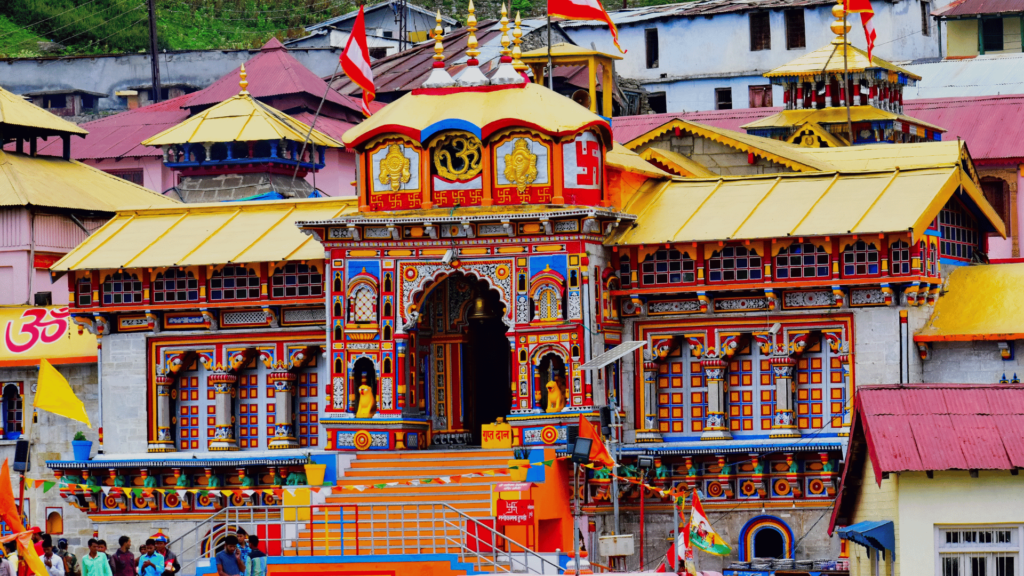
Badrinath Dham is one of the most revered pilgrimage sites for Vaishnavites and a key destination in the Chota Char Dham Yatra. Known as one of the 108 Divya Desams, where Lord Vishnu incarnated in human form, this sacred temple holds immense spiritual significance. Also referred to as Vishalpuri or Vishnudham, Badrinath is believed to be the place where Lord Vishnu sought peace and solitude. The name “Badari” is derived from the wild berries that grow abundantly in the region, and according to the Vishnu Purana, it is here that Goddess Lakshmi transformed into a berry tree to protect Lord Vishnu from the harsh sunlight during his meditation.
Spiritual Importance and Legends
The significance of Badrinath Dham is rooted in the mythology of Lord Vishnu, who is lovingly called Badari Vishal because of the association with the wild berry tree. This sacred site is not only the residence of Lord Vishnu but also a place that attracts pilgrims, sages, and spiritual seekers from around the world. Many come to meditate in search of peace, blessings, and enlightenment.
Badrinath Dham is located in the Chamoli district of Uttarakhand, perched at an altitude of 3,100 meters (10,171 feet). The temple sits between the majestic Nar and Narayan mountain ranges, along the banks of the serene Alaknanda River, offering an awe-inspiring view of nature’s grandeur.
A Convenient and Accessible Journey
Unlike other temples in the Char Dham circuit, Badrinath is easily accessible by road, requiring no trekking for visitors. This makes it an ideal location for pilgrims seeking a more accessible route to experience the divine presence of Lord Vishnu. During the winter months, the temple closes, and the idol is moved to Joshimath, which serves as the winter seat of Badrinath.
Timings and Accessibility
The Badrinath temple is open from 4:30 AM to 9:30 PM during the pilgrimage season. However, the temple closes during the winter months, and the idol is relocated to Joshimath. As part of the Chota Char Dham Yatra, Badrinath offers a unique opportunity for devotees to connect deeply with Lord Vishnu while enjoying the natural beauty and tranquility of the surroundings.
A Pillar of Devotion in the Chota Char Dham
Badrinath Dham is not only an essential part of the Chota Char Dham pilgrimage but also a place where the divine and the natural world come together in perfect harmony. It continues to draw millions of devotees, making it a significant destination for those seeking spiritual awakening and peace.
The 5 kedar in Uttarakhand
The Five Kedar temples are some of the most revered shrines dedicated to Lord Shiva, and they hold immense spiritual significance for his devotees. Nestled in the stunning Himalayan landscape, these sacred temples are an integral part of the Panch Kedar pilgrimage, offering a deeply enriching spiritual journey. While the Chota Char Dham pilgrimage circuit is widely known, the Five Kedar temples provide an extension of this divine route, drawing both pilgrims and travelers alike to explore these remote and awe-inspiring sites.
1. Madhyamaheshwar Temple – The Nabhika of Shiva
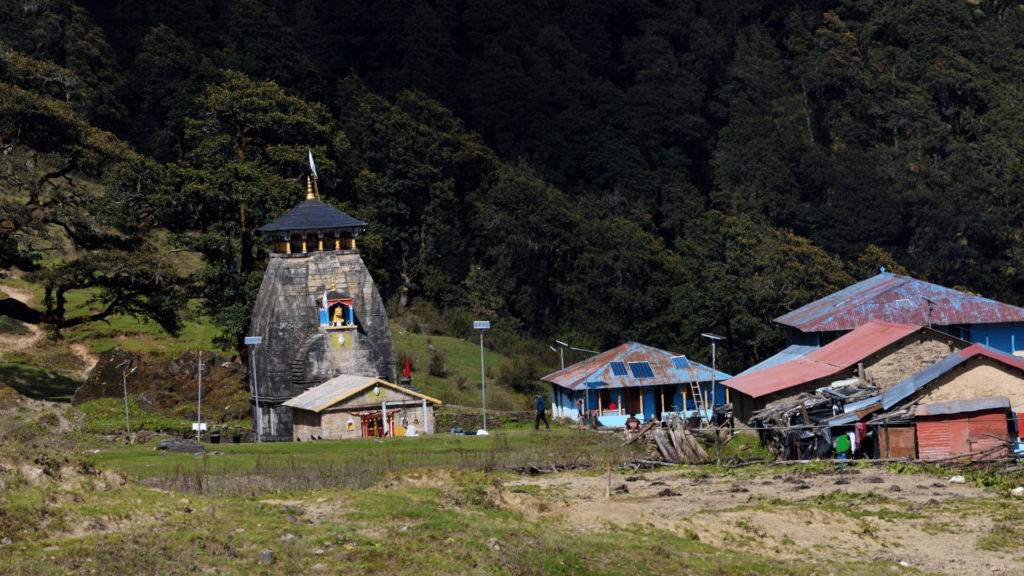
Location: Madhyamaheshwar Valley, near the Ukhimath Village
Significance: Nestled at an elevation of 3,289 meters, Madmaheshwar is dedicated to Lord Shiva as the “middle” deity. This temple is often less frequented, offering a tranquil environment ideal for introspection and spiritual reflection.
Highlights:
• Scenic Trek: The journey to Madmaheshwar from Ukhimath winds through lush greenery and picturesque landscapes. Its lesser-known trails provide an opportunity for peaceful contemplation away from the hustle and bustle.
Cultural Heritage: The region is rich in local myths and traditions, providing a unique cultural experience that deepens the connection between visitors and the spiritual significance of the area.
How to Get There
By Road: Drive to Chopta, located roughly 30 kilometers from Ukhimath.
By Trek: From Chopta, enjoy a brief trek of about 3 kilometers to reach the temple.
How to Get There
By Road: Drive from Joshimath to Ukhimath, which is approximately 60 kilometers away.
By Trek: From the village of Guptkashi, trek about 19 kilometers to reach the temple.
Timings
Morning Aarti – 6:00am – 7:00am
General Darshan Time – 7:00am – 6:00pm
Evening Aarti Time – 6:30pm – 7:30pm
2. Tungnath - the highest temple devoted to Lord Shiva
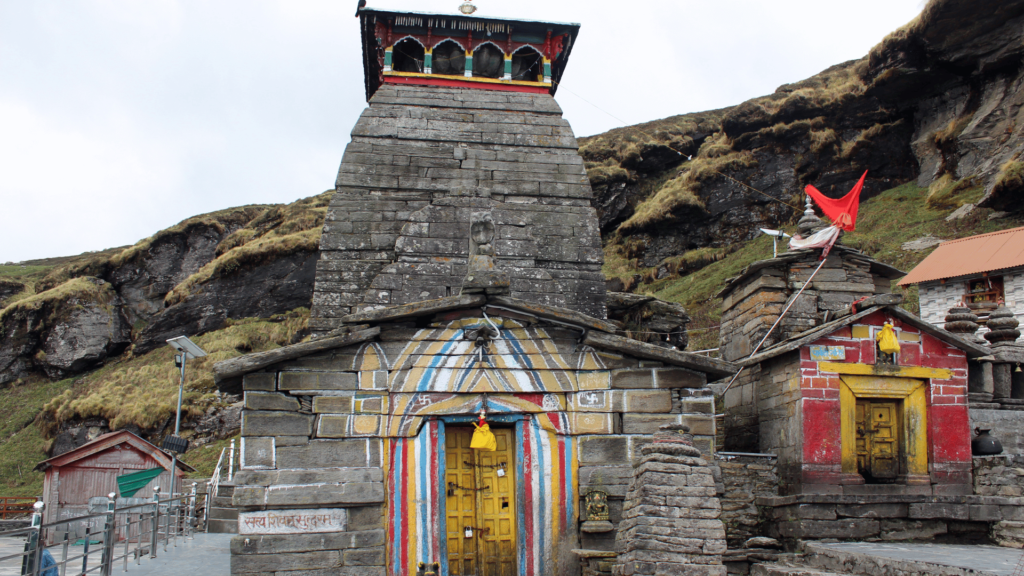
Location: Chopta region
Significance: Standing at an impressive altitude of 3,680 meters, Tungnath is the highest of the Five Kedar temples and is dedicated to the arms of Lord Shiva. This site is a favorite among both pilgrims and trekkers alike.
Highlights:
•Breathtaking Views: The trek to Tungnath rewards hikers with stunning panoramic views of the Himalayan range. The nearby Chandrashila peak is a prime spot for witnessing breathtaking sunrises and sunsets.
•Adventurous Journey: The trek is relatively accessible, making it a popular choice for adventure seekers. It offers a perfect blend of spirituality and physical challenge, attracting those looking for both a spiritual and exhilarating experience.
How to Get There
By Road: Travel to Chopta, located roughly 30 kilometers from Ukhimath.
By Trek: From Chopta, embark on a brief trek of approximately 3 kilometers to reach the temple.
Timings
Morning Aarti – 6:00 am
Morning Darshan Time – 7:00am – 12:00pm
Evening Aarti – 6:30 pm
Evening Darshan Time – 3:00pm – 7:00pm.
3. Rudranath Temple – The Face of Rudra
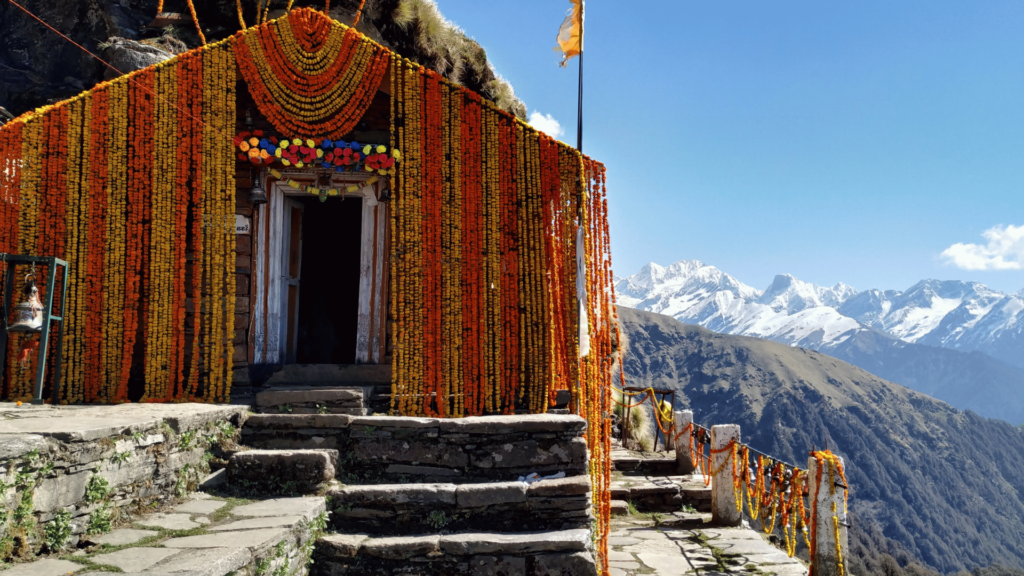
Location – Chamoli district
Rudranath Temple is situated at a remarkable altitude of 2,286 meters, surrounded by lush greenery and stunning natural scenery. Accessing this sacred destination involves a trek that begins in the village of Gopeshwar. The temple itself, standing at 3,600 meters (11,812 feet), is dedicated to the visage of Lord Shiva, who is honored here as Neelkanth, the deity with the blue throat. Local legends tell that after assuming the form of a bull in Kedarnath, Lord Shiva’s face appeared at this revered site.
Significance: Rudranath holds immense importance as a site where Lord Shiva revealed his true nature. This temple is distinct because it showcases a face (mukh) of Shiva instead of the customary lingam, adding to its unique spiritual allure.
Highlights
Perched at 2,286 meters, Rudranath offers spectacular vistas of the nearby mountain ranges and is enveloped by vibrant meadows. The trek leading to the temple is moderately challenging, usually starting from the village of Gopeshwar.
Best Time to Visit
Rudranath Temple welcomes visitors starting in May and remains open until November. The period following the monsoon is especially picturesque for trekking, highlighting the breathtaking beauty of the region.
Getting to Rudranath is a challenging adventure, as pilgrims navigate through thick forests, expansive meadows, and steep inclines. Yet, this trek is a true testament to one’s devotion, leading to a serene environment and a deep spiritual experience at Rudranath.
How to Get There
By Road: Drive from Joshimath to Ghandruk, which is about 40 kilometers away.
By Trek: The trek from Ghandruk to Rudranath spans approximately 23 kilometers.
Timings
Morning aarti – 6:00 am – 8:00 am
Morning Darshan General Time – 8:00am – 1:00pm
Evening Aarti – 6:30pm – 7:30pm
Evening Drashan General Time – 4:00pm – 7:30pm
4. Kalpeshwar Temple – The Jata of Shiva
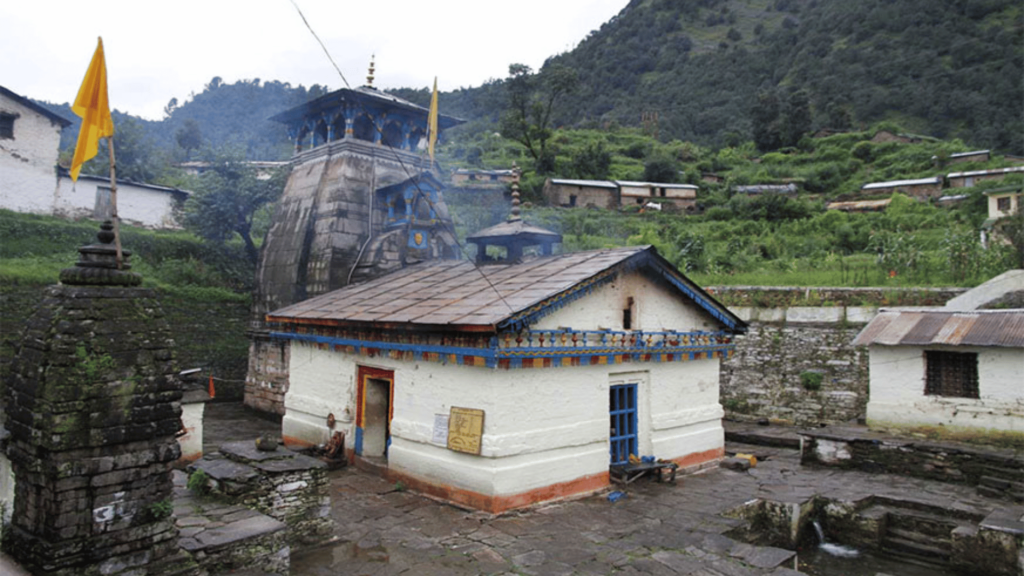
Location – Urgam Valley near the Helang village
Kalpeshwar is situated at an altitude of 2,200 meters in the
picturesque Urgam Valley. In contrast to the other Kedar temples, Kalpeshwar is open throughout the year, allowing visitors access even in winter. Dedicated to Lord Shiva’s hair, known as Jata, this temple is unique among the Panch Kedar for its consistent accessibility, remaining open even when heavy snowfall forces the other temples to close. According to legend, after Lord Shiva vanished at Kedarnath, he reemerged as Jata at Kalpeshwar. Nestled amidst lush forests and stunning landscapes, the temple provides a serene environment that is ideal for meditation and reflection. Significance Kalpeshwar is an esteemed temple devoted to Lord Shiva, uniquely embodying him through his hair (jata). This holy site is especially meaningful for individuals seeking spiritual peace and reflection. Legends suggest that it is the spot where a lock of Lord Shiva’s hair fell to earth, making it a beloved destination for pilgrims. While it may not be as widely recognized as some other temples, its importance is deeply felt among devotees who come to find comfort and a connection with the divine. Highlights of Kalpeshwar
Situated at an altitude of 2,134 meters, Kalpeshwar is the only Kedar temple that remains accessible throughout the year. The peaceful ambiance and breathtaking landscapes make it an ideal spot for meditation and reflection. Must-See Attractions
Kalpeshwar Temple: This temple, while simple in structure, is beautifully nestled amidst majestic mountains and lush greenery.
Natural Hot Springs: The area surrounding Kalpeshwar features natural hot springs, providing visitors with a unique and relaxing experience.
Trekking Trails: The quiet trails leading to Kalpeshwar offer a wonderful escape for those looking to immerse themselves in nature and enjoy moments of solitude. Best Time to visit The temple welcomes visitors throughout the year, but the ideal time to experience it is during the summer months, when the weather is most enjoyable. Kalpeshwar remains accessible from May to November, making summer the prime season for exploration due to its favorable conditions. How to Get There By Road: Travel from Haridwar or Rishikesh to Joshimath, covering approximately 280 kilometers.
By Trek: Once in Joshimath, hire a taxi to Helang and embark on a 2-kilometer trek to reach the temple.
Timings – 6:00 am – 6:00 pm
5. The Dhari Devi Temple
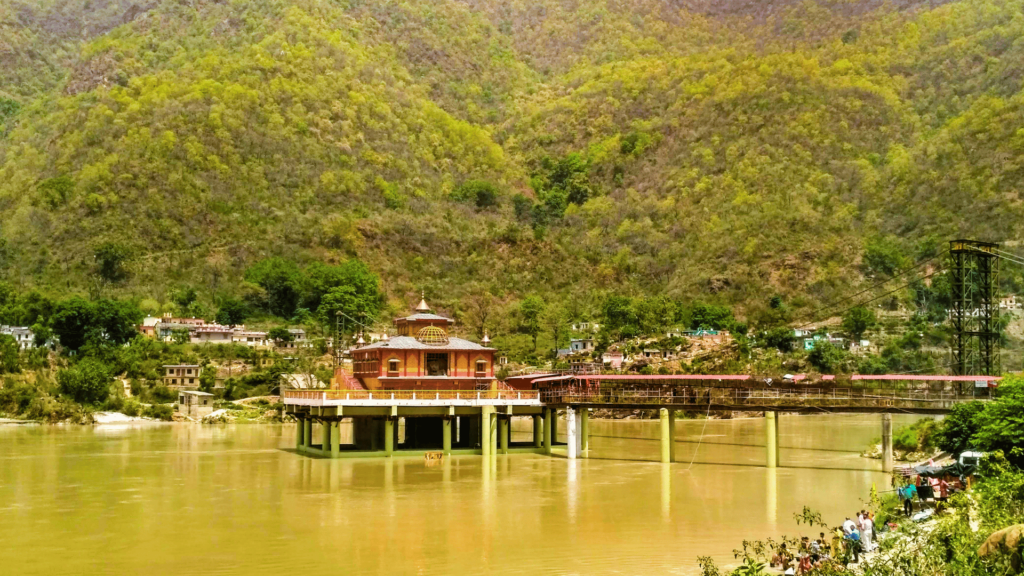
Situated amidst the breathtaking mountains and unspoiled landscapes of Uttarakhand, the Dhari Devi Temple is a beacon of spiritual tranquility and cultural heritage. This sacred site, enveloped by the stunning beauty of the Himalayas, attracts pilgrims, travelers, and those in search of peace alike. Revered as the guardian of the Char Dham pilgrimage, Goddess Dhari Devi is worshipped by both locals and visitors.
The name “Dhari” translates to “the one who holds” or “the bearer,” while “Devi” means “goddess.” Located near the town of Srinagar, this temple is dedicated to Goddess Dhari Devi, believed to protect the sacred journeys to Yamunotri, Gangotri, Kedarnath, and Badrinath.
With a rich legend surrounding it and a stunning temple to explore, Dhari Devi is an essential destination for anyone seeking spiritual renewal or wishing to immerse themselves in the natural beauty of the region. Join us as we delve into the history, significance, and unique aspects of this revered temple.
Historical Significance
The Dhari Devi Temple is steeped in rich historical significance that spans centuries. Local legends tell of its establishment to honor Goddess Dhari Devi, revered as a symbol of power and protection. Devotees believe she safeguards the Char Dham pilgrimage sites from natural disasters and ensures the safety of all who travel there.
The temple’s location enhances its historical allure. Originally positioned on the banks of the Alaknanda River, it was relocated to higher ground in 2013 to protect it from flooding during the catastrophic floods that affected Uttarakhand. This move has reinforced the belief among devotees that the goddess is a true guardian, watching over and guiding her followers.
According to legend, the upper portion of Goddess Kali is enshrined at the Dhari Devi Temple, while her lower portion resides in Kalimath. It is believed that the goddess undergoes a transformation over time, shifting from a girl to a woman and eventually to an elderly figure.
The temple’s name is derived from a captivating story. When floods once swept away the original temple, the idol of Goddess Kali was said to strike a rock. Villagers from the nearby Dharo village, upon hearing the goddess’s divine voice, revered the idol and placed it at
the current site, leading to the name “Dhari Devi.”
A captivating belief associated with the Dhari Devi Temple is that the idol of the goddess should always be exposed to the open sky, symbolizing its divine nature. As a result, the temple remains uncovered. Additionally, photography of the idols is not permitted, helping to maintain the sacredness of the space.
The need for the temple’s relocation arose due to the impacts of the Srinagar Hydel Project, ensuring its preservation and continued significance in the region.
Many devotees believe that the catastrophic floods of 2013 were a result of the goddess’s displeasure, reinforcing her role as the guardian of Uttarakhand and the protector of the Char Dham pilgrimage. Although the temple attracts visitors throughout the year, the number of pilgrims increases notably during Navratri, showcasing the profound respect and devotion that people have for Dhari Devi.
Key Features
Main Idol: The centrepiece of the Dhari Devi Temple is a captivating wooden idol of Goddess Dhari Devi, intricately adorned and portrayed in a fierce form that highlights her protective essence.
Temple Surroundings: Nestled amidst verdant greenery, the temple offers breathtaking views of the Alaknanda River, fostering a serene environment ideal for meditation and contemplation.
Spiritual Significance
For devotees, Dhari Devi represents more than just a deity; she embodies hope and protection. Many pilgrims stop at the temple before beginning their Char Dham yatra, seeking the goddess’s blessings for a safe and meaningful journey.
Beliefs and Practices
Worship: Devotees bring prayers, flowers, and traditional sweets as offerings, seeking blessings for their families and travels.
Festivals: Major celebrations, especially during Navratri, draw large crowds, featuring special rituals and festivities that honor the goddess.
Best Time to Visit the Temple
The temple welcomes visitors throughout the year, but it truly shines during Durga Puja and Navratri, when it is adorned in festive splendor. Temple hours are from 6 AM to 12 PM and 2 PM to 7 PM.
If you’re planning a pilgrimage to Dharvi Devi, the revered guardian of the Chote Char Dham in Uttarakhand, choosing the right time can greatly enhance your experience.
Ideal Seasons
Spring (March to June): This is the prime season for a visit. The weather is delightful, with temperatures ranging from 15°C to 25°C, making it perfect for trekking and exploration. The vibrant flowers and lush greenery create a beautiful backdrop for your spiritual journey.
Autumn (October to November): Another excellent time to visit, characterized by clear skies and refreshing air. The post-monsoon scenery offers stunning views, while the cooler temperatures ensure a comfortable atmosphere for pilgrims.
Monsoon Precautions
Monsoon Season (July to September): While the region flourishes with greenery, heavy rains can cause landslides and challenging travel
conditions. For safety reasons, it’s best to avoid visiting during these months.
How to Get There
Dhari Devi Temple, located in Kalimath, Uttarakhand, is a significant pilgrimage site dedicated to the revered deity, Dharvi Devi. Here’s how you can reach this sacred location:-
By Air
Nearest Airport: The closest airport is Jolly Grant Airport in Dehradun, situated about 180 km from Kalimath. From the Airport: You can hire a taxi or take a bus, with the journey taking approximately 6-7 hours.
By Train
Nearest Railway Station: The nearest railway station is Rishikesh, located about 150 km away. From Rishikesh: Taxis and buses are available to Kalimath, with travel time estimated at 5-6 hours.
By Road
From major cities: Rishikesh: Approximately 150 km; follow NH58 and then local routes. Haridwar: Roughly 160 km; take NH58 and local roads. Dehradun: Approximately 180 km away; take NH7 and follow the local routes for directions. Public Transport: Buses and shared taxis operate from major cities to Rudraprayag, where you can find local transport to Kalimath.
Local Transport
Once in Kalimath, the temple is easily accessible by foot. The scenic surroundings enhance the experience, making the walk a delightful part of your Pilgrimage.
Timings – 6 AM to 12 PM and 2 PM to 7 PM.
In conclusion
the Chota Char Dham Yatra offers a unique spiritual experience, taking pilgrims through the divine landscapes of Yamunotri, Gangotri, Kedarnath, and Badrinath. With its serene environment and rich cultural heritage, this sacred pilgrimage is a must-visit for those seeking peace, devotion, and natural beauty. At Victoria Exotica Pvt. Ltd., we are committed to providing you with a seamless and memorable journey, ensuring you experience the true essence of these holy destinations. Let us help you make your Chota Char Dham pilgrimage an unforgettable adventure!


